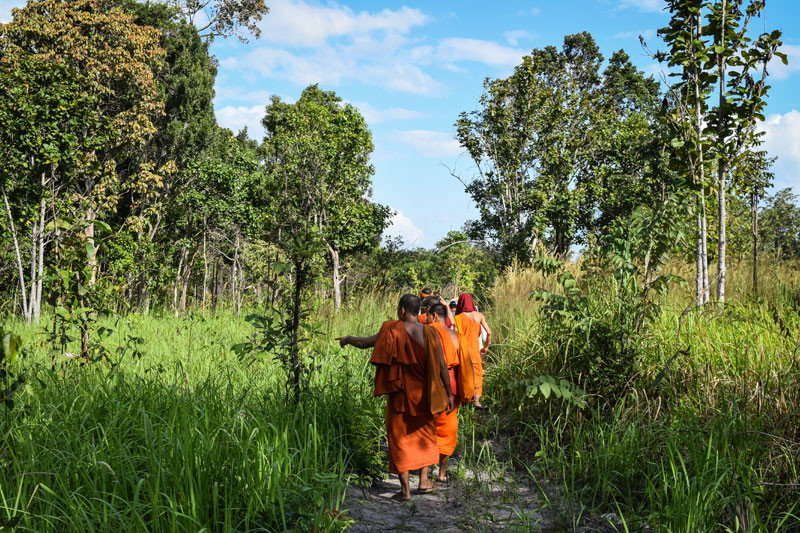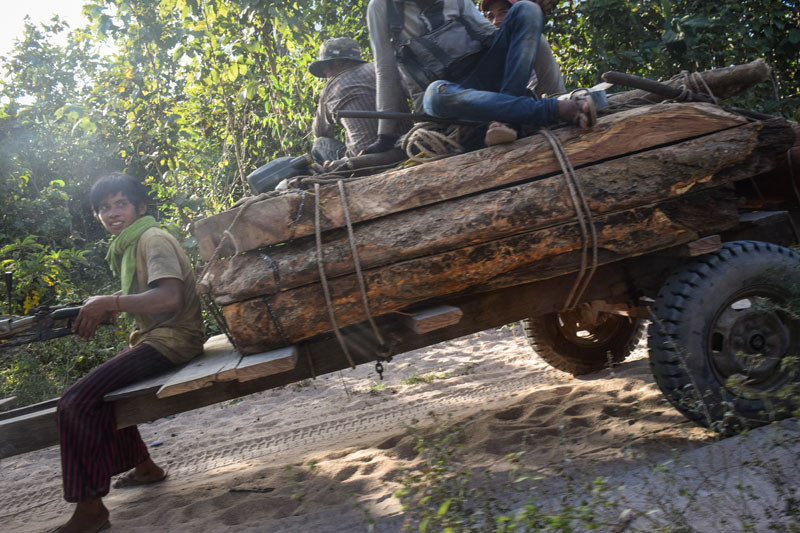ORAL DISTRICT, Kompong Speu province – A steady stream of tractors loaded with timber clambered along the dirt roads heading out of the Phnom Aural Wildlife Sanctuary last week, some carrying cheap firewood, others loaded with more valuable logs.
As in many ostensibly protected areas across the country, Phnom Aural—Cambodia’s tallest mountain at over 1,800 meters—has fallen victim to rampant logging, both by outsiders and locals who have long relied on the dense forests but are desperate to make money and have few other options.

“I think in the next 10 years the forests will be completely destroyed because no one takes any action to protect it,” said Kay Kin, a rice farmer who lives just outside the wildlife sanctuary. “The authorities are useless.”
However, Ven Dhammajat, a charismatic 44-year-old monk, is holding out hope.
The monk and environmental activist arrived in Pur Meas village, a small community of about 100 families near the foot of Phnom Aural, in 2000 and has since set about creating Metta Nature, a sandy enclosure that serves as his headquarters and home.
At one end of the strip of land is a small temple with one side covered in posters about the environmental NGO Mother Nature, which Ven Dhammajat cofounded. At the other end is a simple house for locals who look after visiting monks and tourists. Surrounding the center are trees, many with saffron cloth attached to them.
For two days last week, Ven Dhammajat led a group of foreign environmental activists and monks to bless trees throughout the eastern foothills of the Cardamom mountains, which stretch into the Aural sanctuary, tying cloth around some and nailing it to those with particularly wide trunks.
He hopes the strips of cloth, the same color as the robes worn by monks throughout Southeast Asia, will defend against the forces that have led to the destruction of much of the forest that once blanketed the area around Phnom Aural.
“The cloth is to show that people have abstained from cutting [the] tree, something they should do for all the trees in Cambodia and in the world,” Ven Dhammajat said in an interview this week.
Having led ceremonies since moving to the area 15 years ago, the monk said he has lost count of how many trees he had blessed.
“What I did is from my mind, idea and experience. From studying the words of the Buddha, I have [taken] some words to make prayers to ordain or to bless the trees,” he said.
Erik Davis, a scholar of Buddhism and an associate professor at Macalester College in the U.S., said that blessing and ordaining trees—the act first recorded in Thailand in 1988—was not founded in any Buddhist tradition.
“It’s not a ‘real’ ordination for all sorts of reasons,” he said in an email last week, noting that actual monks must be human.
“It is instead a symbolic protest of sorts, though [Cambodian monks] also acknowledge that they hope it will make loggers afraid to cut the trees down, which implies something more.”
Sue Darlington, a professor at Hampshire College in the U.S. who has written extensively on Thailand’s “ecology monks,” describes the underlying principle behind the practice in a 1998 academic paper.
“[Blessing trees] made the protection or destruction of the forest karmic action: Protecting it would confer good merit (bun), destroying it bringing bad, the balance of which would ultimately affect one’s rebirth,” she wrote.

Ms. Darlington said in an email this week that there was a great deal of “cross communication” between monks in the region.
“Of course, people in specific locales search for approaches that are relevant for their own place and people, and there are innovations in each place. But I would suspect that the idea of wrapping orange robes around trees has been floating around in the region for a while and has influenced new forms,” she wrote.
For Ven Dhammajat, the sharing of metta—altruistic love—with the trees, and symbolizing this act by attaching the orange cloth, is meant to inspire loggers to stop and think.
“The blessing is just to make people think about the trees and other things. In the traditional beliefs some people think trees with a robe on should be avoided and not harmed,” he said.
Mr. Kin, the rice farmer, said it was working—some of the time.
“When the monks tie the robes around the trees, the people see this and don’t cut the trees; it’s like they see the monks,” he said. But sometimes, he added, “people still cut the trees because they are so far away and no one is near.”
Despite committing his life to protecting trees, Ven Dhammajat is not hopeful about the future of the country’s forests.
“I’m not optimistic that the trees will be saved when the law and the morality of [the] country has not been improved,” he said. “I cannot reform the laws of the country by myself.”
But those living around Phnom Aural insist that the work being done by the monk is not futile.
Pork Chum, the chief of Pur Meas village, said Ven Dhammajat‘s presence in the area had made a clear impact.
“Before he came, many people cut trees to make firewood and charcoal, but now no one does,” he said last week. “If they protected every tree it would be great.”




